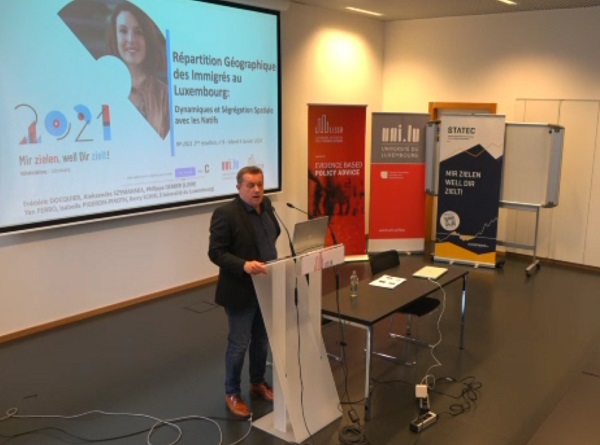 Credit: Screenshot via Webex
Credit: Screenshot via Webex
On Tuesday 9 January 2024, Luxembourg's national statistical office, STATEC, held an economic seminar dedicated to a new publication about the Geographical Distribution of Immigrants in Luxembourg - Dynamics and Spatial Segregation with Natives.
One of the co-authors of the publication, Frédéric Docquier, Crossing Borders Research Programme Leader at the Luxembourg Institute of Socio-Economic Research (LISER), delivered the one-hour conference in French; the event took place both in person, on LISER's premises, and online via Webex.
The publication is based on the 2021 population census in Luxembourg and characterises the geographical distribution of the immigrant population at the level of Luxembourgish municipalities and the fine geographical cells (1 km²) within them - the 2021 census marked the first time that STATEC published statistics at such a fine geographical level. The publication highlights the heterogeneous locations of immigrants according to their region of origin and duration of stay. It also compares these locations with those of Luxembourg-born individuals, or "natives", highlighting the differences in spatial segregation between the groups and their geographical breakdown. Finally, the publication analyses the specific location patterns of "natives" born to two Luxembourg-born parents and second-generation immigrants born in Luxembourg but with at least one parent who was born abroad.
Frédéric Docquier began by pointing out Luxembourg's significant foreign population, i.e. 49.3% of the total population in 2021. He added that the presence of non-Luxembourgish residents varied at the municipal level, from 21.8% of the population in Wahl to 72.7% in Luxembourg City, but affected every municipality. Where foreign residents lived was found to depend on both their country or region of origin and their length of stay in Luxembourg.
Residents who were born in Portugal (representing 11.3% of the total population) were found to live predominantly in municipalities in the south and north-east of the country, i.e. in the former steel and textile industrial regions, as well as in Larochette (a historic textile centre).
Residents born in neighbouring countries (i.e. 12.9% of the total population) were found to live mainly in Luxembourg City and bordering municipalities. Similarly, Luxembourg City was seen as the "port of entry" for more recent arrivals who were born in either other EU countries (9.6% of the total population) or outside the EU (15.5% of the total population). These groups were found to be concentrated in other urban clusters aroung the capital as well.
On the other hand, Luxembourgers born to two Luxembourgish parents were more present in rural areas. The geographical distribution of second-generation immigrants reflected that of Portugal-born residents - Frédéric Docquier attributed this in part to the fact that many second-generation Luxembourgers are descendants of Portuguese immigrants. Very few Luxembourgers, regardless of their parents' country of origin, were living in Luxembourg City at the time of the 2021 census.
The seminar (and the publication) also looked at spatial segregation (i.e. whether or not foreign residents and "native" Luxembourgers lived "separately") and found that this was low to moderate, regardless of the place of origin or length of stay of immigrants. As such, spatial segregation is not seen as a "major obstacle" to integration and "living together".
Later, in the question and answer session that followed, Frédéric Docquier recalled that an immigrant's place of residence may depend on various factors, not only housing prices but also access to employment or healthcare, among other things. As such, as highlighted in the publication, the concentration of immigrants in specific areas can be seen as "a determining factor in their integration process, influencing their interactions with the native population and shaping the development of a sense of belonging".
The publication is available in full from STATEC's website: https://statistiques.public.lu/en/publications/series/rp-2021/2023/rp21-09-23.html. Additional publications looking at different aspects of the 2021 census are planned throughout 2024.








